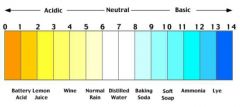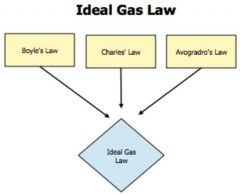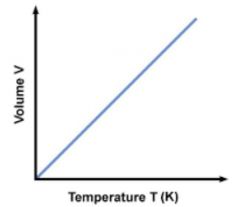![]()
![]()
![]()
Use LEFT and RIGHT arrow keys to navigate between flashcards;
Use UP and DOWN arrow keys to flip the card;
H to show hint;
A reads text to speech;
95 Cards in this Set
- Front
- Back
|
To be isotopes, two atoms of the same element must have a different number of: |
Neutrons |
|
|
Depending on its environment, a substance that can act as either an acid or a base is described as: |
Amphoteric |
|
|
A certain substance is not broken down in a chemical reaction. The substance is most likely: |
An element |
|
|
A hydrogen ion concentration of 1 x 10-7 M in a solution is considered: |
Neutral |
|
|
The heart is composed of what tissue type: |
Cardiac muscle |
|
|
Which of the following reactions releases heat energy: a. double replacement b. decomposition c. endothermic d. exothermic |
d |
|
|
What gas law states that the volume of a gas is inversely proportional to the pressure: |
Boyles law |
|
|
The xylem vessels of a plant are responsible for carrying: |
Water up through the plant. |
|
|
When placed in distilled water, a human RBC: |
Swells to a larger size |
|
|
During plant cell replication, the division of the cytoplasm is called: |
Cytokinesis |
|
|
Digestive enzymes can be found in which cellular organelle: a. lysosomes b. mitochondria c. ribosomes |
a |
|
|
The process by which an enzyme acts on the substrate can be described by the: |
Lock-and-key model |
|
|
When an organism contains chloroplast in its cells, the color of the organism would most likely be: |
Green |
|
|
The strongest acid can be found in which of the following pH ranges: a. 11.1-12 b. 7.1-8.2 c. 4.5-5.7 d. 1.0-2.0 |

d |
|
|
N |
Nitrogen |
|
|
Na |
Sodium |
|
|
Cl |
Chlorine |
|
|
C |
Carbon |
|
|
Co |
Cobalt |
|
|
Ne |
Neon |
|
|
Au |
Gold |
|
|
Ag |
Silver |
|
|
O |
Oxygen |
|
|
K |
Potassium |
|
|
Cu |
Copper |
|
|
H |
Hydrogen |
|
|
He |
Helium |
|
|
Fe |
Iron |
|
|
Nb |
Niobium |
|
|
Hg |
Mercury |
|
|
B |
Boron |
|
|
F |
Fluorine |
|
|
Boyle's law + Charles' law + Avogradro's law = |

Ideal gas law |
|

The equation shows that, as absolute temperature increases, the volume of the gas also increases in proportion: |
Charles' law |
|
|
The ________ Gas Law states that a gas pressure x volume x temperature = constant |

Combined |
|
|
Universal donor |
Type O |
|
|
Universal recipient |
Type AB |
|
|
Blood type A can donate to: |
A's & AB |
|
|
Blood type B can donate to: |
B's & AB |
|
|
Blood type AB can donate to: |
AB only |
|
|
Carbohydrates and starches must be changed to ______ so that they can be used by cells. |
Glucose |
|
|
The stomach and mouth are connected by the: |
Esophagus |
|
|
The growth and development of bone is assisted by the use of vitamin D because Vitamin D can: |
Aid in the absorption of calcium |
|
|
Synapses are the gaps between: |
Neurons |
|
|
Provide a greater surface for absorption of materials passing through: |
Villi |
|
|
The process by which oxygen travels from air into your lungs and then into blood is called: |
Diffusion |
|
|
Bile is stored in the gallbladder, and helps digest ____ via _____________. |
-fats -emulsification |
|
|
A light hits a smooth mirror at an angle of 45°. At what angle will the light be reflected: |
45° |
|
|
White light enters a prism and is broken up into colors of the rainbow. This phenomenon is called: |
Dispersion |
|
|
A laser beam of light is pointed through the air and then into a diamond. The beam of light then bends. This results from the process called: |
Refraction |
|
|
An atom becomes an ion that possesses a negative charge. The atom must have: |
Gained electrons |
|

|
Resistance |
|
|
Electrical potential is measured in: |
Volts |
|
|
What term describes the electrons in the outermost principal energy level of an atom: |
Valence |
|
|
Blood with pH of 7.4 indicates that the blood sample is: |
Weakly basic |
|
|
When one liquid evaporates much quicker than another liquid, the first liquid is said to be more: |
Volatile |
|
|
When solid iodine becomes gaseous iodine with no apparent liquid phase in between, the process is called: |
Sublimation |
|
|
Which color pairing of light is most beneficial for photosynthesis: |
red/blue |
|
|
Which of a plant's organs are responsible for sexual reproduction: |
Flower |
|
|
The smaller molecules that are responsible for synthesis of starches are called: |
Monosaccharides |
|
|
Separating the left and right sides of the heart is the: |
Septum |
|
|
A secondary defense for the body against pathogens is: |
Inflammation |
|
|
The larynx is covered by the __________ so that food does not enter the trachea. |
epiglottis |
|
|
The organ that works to detoxify the blood and to produce bile is the: |
Liver |
|
|
Ligaments hold: |
Bone to bone |
|
|
A protease is an enzyme that works to digest: |
Proteins |
|
|
Newton's third law describes: |
Forces |
|
|
Newton's second law describes: |
Acceleration |
|
|
Newton's first law describes: |
Inertia |
|
|
Newtons (N) are measured in: |
kg·m/s2 |
|
|
What is the name of the muscular tissue that contracts to permit air to enter the lungs: |
Diaphragm |
|
|
What is the function of a lysosome's membrane: |
It isolates and acidic environment for the lysosome's hydrolytic enzymes from the neutral pH of the cytoplasm. |
|
|
Oogenesis is the process by which: |
Primary oocytes produce eggs |
|
|
In a neutral atom the number of electrons is: |
Equal to the number of protons |
|
|
An element that contains a full outer shell is called a: |
Noble gas |
|
|
The location for the exchange of oxygen and carbon dioxide through thin membrane walls: |
Alveoli |
|
|
Rods and cones are light-sensitive cells inside the eye's: |
Retina |
|
|
Most of the nutrients in food are absorbed in the body's: |
Small intestine |
|
|
Carbohydrates include: |
-Starches -Sugars |
|
|
In adult humans RBCs: |
Have no nucleus |
|
|
Saliva in the mouth begins the process of breaking down: |
Starch |
|
|
The atom of an element with an atomic number of 17 must have: |
17 protons |
|
|
An atom that is not electrically neutral is called: |
An ion |
|
|
The greater the electronegativity of an atom: |
The greater its attraction for bonding electrons is |
|
|
At high altitudes, the boiling point of water is _____ than at sea level. |
lower |
|
|
In electricity, a unit of resistance is called a(n): |

Ohm |
|
|
The energy of movement is known as: |
Kinetic energy |
|
|
The gallbladder is part of the _________ system. |
digestive |
|
|
The elbow is ______ to the shoulder. |
distal |
|
|
The ear is medial to the _______. |
cochlea |
|
|
What is the function of the vacuole: |
Storage |
|
|
What results from the first stage of meiosis: |
Two diploid cells |
|
|
What is the function of B cells: |
Production of antibodies |
|
|
What system controls metabolism: |
Endocrine |
|
|
Most human digestion takes place in the: |
Small intestine |

